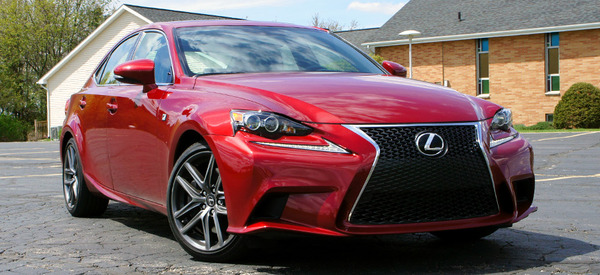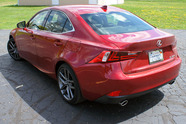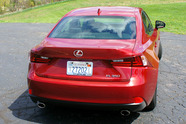
2014 Lexus IS
2014 Lexus IS Review
BMW beware: Lexus is serious this time.
Web2Carz Contributing Writer
Published: May 14th, 2013
Lexus has been trying to beat BMW at the mid-size sports sedan game since 1998, joining Cadillac, Mercedes-Benz, and Audi in attempts to out-do the much-loved BMW 3-Series. The first and second generations of the Lexus IS fell short of the mark, but that doesn't mean they were terrible cars -- far from it. But overall competence isn't enough to get enthusiasts shopping in the near-luxury sports-sedan segment to part with their money. The previous IS was derided as a bit of a poser -- it looked like a better performer than it was, and while its on-road manners were acceptable, they didn't measure up to the Bimmer. Not only that, but Audi's A4 has long been a solid choice in the segment.
Cadillac also upped its game in the segment with the addition of the ATS sports sedan. The ATS has had the 3-Series in its sights since the get-go, and in our opinion, the ATS comes very close to de-throning the 3-Series as the king of the class. Lexus has its work cut out for it.
-

On the Road
There are two levels of IS: 250 and 350. Following Lexus style, the numbers denote engine size: the 250 is powered by a 2.5-liter V-6 that makes 204 horsepower, and the 350 has a 3.5-liter V-6 making 306 horsepower. Both have rear-wheel-drive standard, and both are available with all-wheel-drive. Buyers who opt for a 250 or an all-wheel-drive 350 get a six-speed automatic transmission, while those who select a rear-wheel-drive 350 get an eight-speed automatic.
Lexus is mum on the future availability of a high-performance F model, but an F Sport trim available on all IS models stands as the top performing model. Opting for the F Sport adds an additional driving mode to various choices in the driver-selectable system (more on this later), along with sportier suspension tuning, 18-inch wheels, and unique interior and exterior tweaks.
There are three options that are standard: Eco (adjusts throttle response and cuts air conditioning intensity to improve fuel-efficiency), Normal, and Sport (adjusts throttle response and other factors for more spirited driving). F Sport models change Sport mode to Sport S and add a Sport + mode, to give the car a bit more sporting flair. There's also a Snow mode available on all-wheel-drive cars.
Enthusiasts should note that the suspension and steering are derived from the larger GS sedan, and another feature that will perk up the ears of enthusiasts is the G Force Artificial Intelligence, available on cars with the eight-speed. This system finds the correct gear for a corner and holds it based on the g-forces the car is experiencing.
Perhaps wanting to prove the IS's worth, Lexus gave us our first crack at the car on the road course at Michigan International Speedway before turning us loose on public roads. We got behind the wheel of just about every powertrain combination, save the all-wheel-drive IS 350.
Our immediate takeaway is that the IS is much better than its predecessor, but Lexus still hasn't caught the 3-Series -- or the ATS. Why? Let's delve in below.
Let's start with handling. The good news here is that the IS feels planted and stable in most instances, with steering that is weighted nicely while providing plenty of accuracy. The bad is that when the tires let go, the IS wants to push, push, and push. Understeer is the name of the game (along with a tad bit of body roll), and the car lets go a little sooner than we'd like. All-wheel-drive models hang on a bit more before giving up the ghost, but the car doesn't have the sharp steering and athletic moves of the ATS. Rather, it feels like a slightly heavier/larger car that has good dance moves. It reminds us of the GS in that way -- it's easy to drive fast and beyond competent, to the point of being well above average, but it's missing the secret ingredient that would put it over the top. The good news for Lexus is that the IS is now in the top of the class conversation. The bad news is there's still a gap -- it's just a lot smaller.
Dig into the throttle, and you might not care that the IS can't quite out-handle the ATS. Both engines make lovely noises that make you think a V-8 is underhood, and while acceleration isn't extremely forceful (especially in the 250; the 350 has more guts), it's still plenty strong. You won't need to worry about merging, but the car feels a tad on the heavy side when the gas pedal is floored.
Ride quality is also a plus, although most of the roads we drove were well-manicured, especially by Southeast Michigan standards. The car is tuned to sport, but it's never too harsh or too stiff -- the IS will make a great sleeper commuter car.
Lexus seems to be walking a line between luxury and performance -- even more so than its competitors -- and it walks it well, even if it doesn't quite achieve the performance level of its top rivals. -

Exterior
The IS looks like a baby GS, thanks to the now-familiar Lexus "spindle" grill. The rest of the car uses graceful styling that's on the conservative side, no crazy wings or unruly lines, just a curvy swept look.
The rear fascia does look a bit squished and squinty when it comes to the taillights, with an upturned lip on top of the trunk. -

Interior
Lexus is routinely praised for classy interiors, and the IS is no exception. Its layered design -- complete with an analog clock in the center stack -- is a copy of the larger GS's cabin, and we have mixed feelings about it. On the one hand, the interior materials are typical of Lexus -- well-crafted and class appropriate. The interior feels expensive and well-done, as it should in this class. On the other hand, the design looks a bit odd, as if it lacks cohesiveness. The climate controls look modern, complete with touch sliders, putting them at odds with the analog clock and old-fashioned radio knobs.
We like the speedometer, which is influenced by the same unit in the LFA supercar -- it lends to the IS's sporting intent. We mostly like the computer-mouse-like controller for the infotainment system -- it's intuitive to use, although it does pull the driver's eyes off the road for too long at times. Another issue with the controller is that it can put drinks resting in the cupholder in harm's way, as a driver's elbow will slide right back towards the cupholders if the arm isn't angled right. Otherwise, we're generally happy with the execution of the system.
Lexus promised more rear-seat headroom and legroom (1.6 inches more legroom) than in the outgoing IS, and we found that they seemed to deliver, although taller adults still won't find the environment terribly welcoming. In a first for a Lexus sedan, the IS has a 60/40 split-fold rear seat.
One more note about that interior: should a navigation system be important to you (Lexus says it will be for 65 percent of IS buyers), be prepared to pony up $2,085 for it. Luxury ain't cheap. -

Final Thoughts
The power dynamic in the mid-size luxury sports-sedan class has changed dramatically in a short time. The 3-Series is no longer the undisputed champ, and the IS is no longer an also-ran. Not to mention -- Cadillac, of all brands, is now part of the picture.
Driven sedately, the IS feels like a slightly overweight luxury car that is sporty more in name than in truth. But push it, and it comes into its own as a sports sedan. For perhaps the first time, you can say the IS is equal to tops in the class with a straight face.
Whether that makes it best in class depends entirely on the buyer. Those who prefer their cars to be switched "on" at all times will like the laser-like sharpness of the ATS. The 3-Series will still win over buyers based on its track record alone. But the IS strikes a superb balance. Our enthusiast side still leans towards the ATS, but the emergence of the IS as a true contender makes this battle more than a two-car fight. -

Specs, Features, and Prices
Engine: 2.5-liter V-6 or 3.5-liter V-6
Transmission: Six-speed automatic or eight-speed automatic
Drive Wheels: Rear-wheel-drive or all-wheel-drive
Fuel Economy: 21 mpg city/30 mpg highway (IS 250 RWD), 20/27 (IS 250 AWD), 19/28 (IS 350 RWD), 19/26 (IS 350 AWD)
Base Price: $35,950 (IS 250), $39,465 (IS 350)
Available Features: Dual-zone automatic climate control, Bluetooth, navigation system, infotainment system, pre-collision warning system, lane-departure warning system, rear cross-traffic alert, blind-spot monitoring, USB port, heated and cooled front seats, rearview camera, Mark Levinson premium audio system, sports suspension, performance brake pads, power tilt/telescope steering wheel, satellite radio.
• For more information such as specs, prices, and photos of the 2014 Lexus IS 350, click here: 2014 Lexus IS 350.














